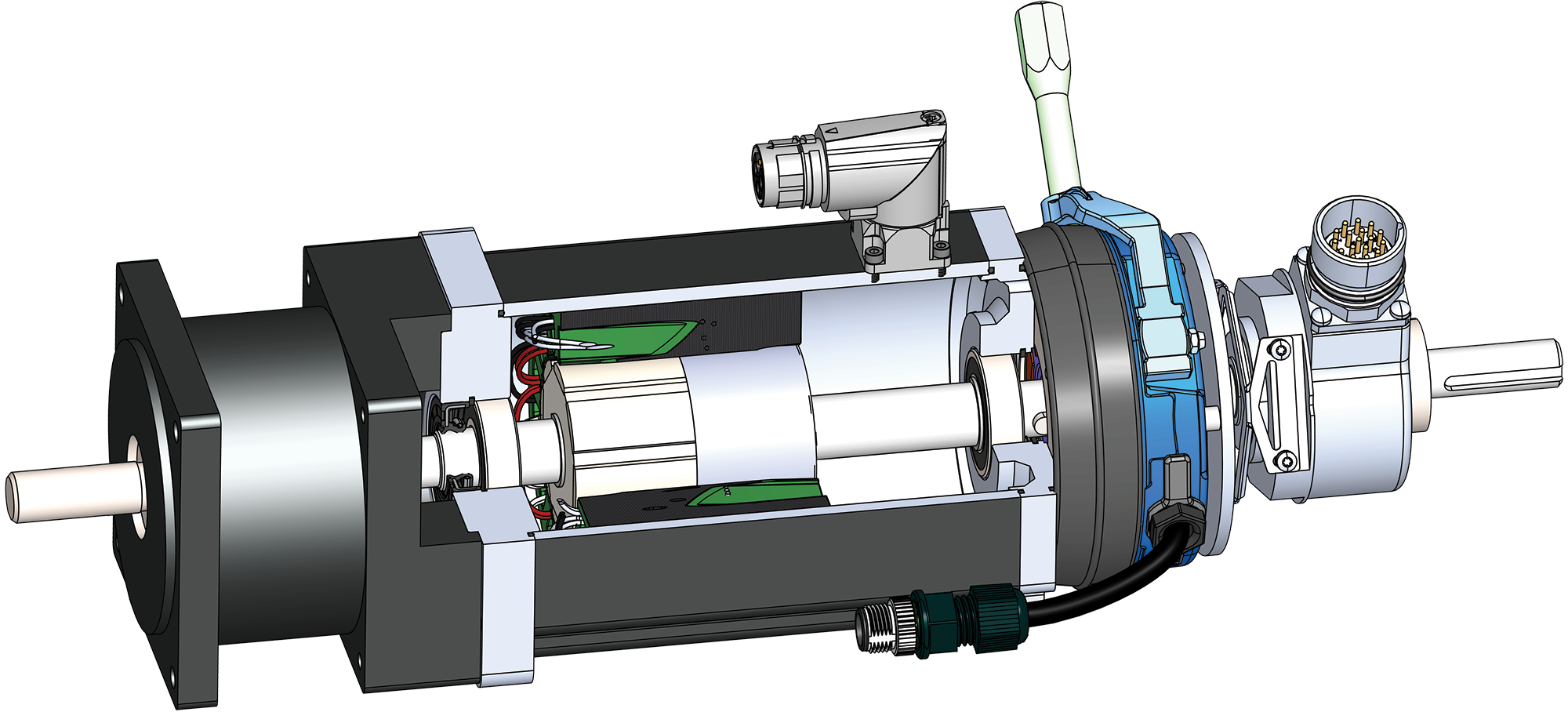Our Optimization Process
From basic to complex, our servo motor solutions lead to your success.

Design implementation is a process by which TruTech delivers performance at a reasonable cost. When we understand your basic needs and system requirements, a baseline is established with the addition of only those needed end goal aspects. This process has proven time and again; mitigating any trade-offs of cost and performance plus includes best manufacturing processes.
The evolution of an optimized servo motor design offers lowest cost regardless of whether it’s all reliable NEMA ICS 16 stocked components or a completely customized design specifically made to your exacting requirements.
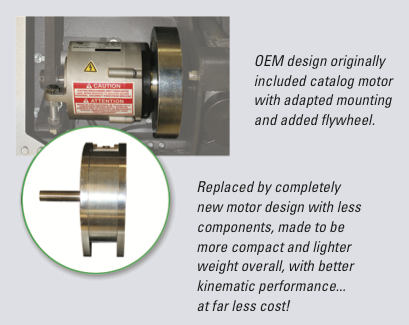
Our Permanent Magnet Servo Motor (PMSM) Solutions Meet or Exceed Catalog Products
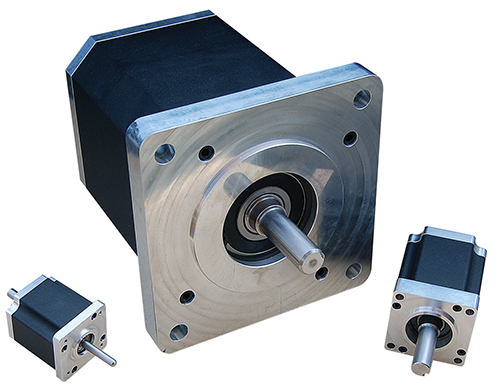
- Wide voltage range including low voltage options (10-80+ VDC) with high currents
- Stocked components to NEMA ICS 16 dimensions along with IEC 142mm and 190mm metric sizes
- Continuous torques from 1.2-600 lb-in available for rapid prototyping
- Standard 416sst shafts, sleeved rotors
- Client specified Kt and Ke to torque and speed specifications
- Performance optimized

Our Permanent Magnet Servo Motors (PMSM) start with motor components designed around popular NEMA ICS 16 standards coupled with windings to meet standard applications at low costs and short lead-times.
These motors are used for quick turnaround and rapid prototyping as components are available off-the-shelf.
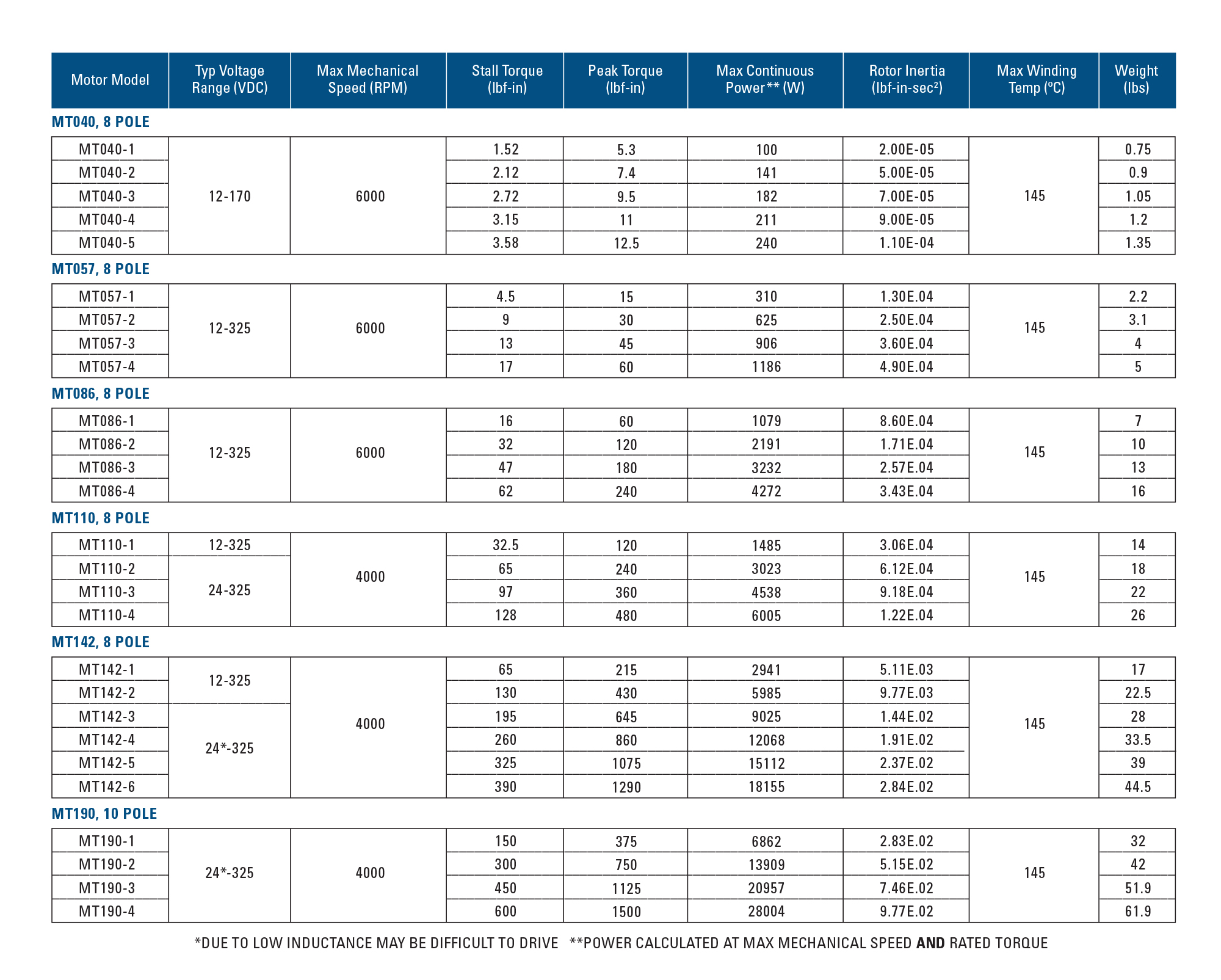
Our Custom-Driven Solutions Provide an Ultimate Level of Performance
During our more advanced design process, we optimize all aspects of motion to assure the machinery or equipment will operate at its maximum performance; allowing most, if not all, motor design parameters – performance, sizing, output mounting, functional components, environmental considerations – to be altered and tailored to the exact requirements of the machine.
PMSM System Considerations and Design Criteria
When considering a PMSM as a part of the entire machine design, most motor design parameters are alterable and can be tailored to the requirements as desired. A systematic and considerations process approach can overcome most limitations and deliver a best possible solution. End results can quickly be prototyped, and production units made readily available.
Things We Consider
The applied voltage to a motor is directly proportional to motor speed. Where higher or lower speeds are required, applied motor voltage may limit desired outcome. However, stator windings can easily be made to specifications that allow for increased or decreased speeds given the voltage requirement, with consideration for torque. This factor is called Ke and given in Volts/krpm and can have a wide range of possibilities.
Available current to a motor is directly proportional to motor torque. Where increased or decreased torque is needed, available current may not always be in line. As well with speed, the stator winding specification can easily be made to increase the torque for lowered available current, with consideration for speed. This factor is called Kt and given in Nm/Amp. Another option to increase torque, where plenty of current is available and overall length is not an issue, is to add to the stator length and/or number of stacks while retaining the frame size.
The nominal or expected voltage sourced to the motor will determine the speed (see above). The windings in the motor are produced knowing that applied voltage. Since power electronics are in the system, i.e. servo drives, the resulting voltage the motor observes is considered DC, whether the power to the electronics is connected to a DC source or rectified DC from an AC line. Motor windings can therefore explicitly be specified for any voltage, including 10-80+ VDC for low voltage needs, typical: 90, 120, 240, 480, 525 VACs line sources or higher. Knowing supply voltage is critical to any application success.
The overall design of the rotor results in the angular mass and determines needed torque while accommodating targeted acceleration/deceleration aspects. Considering in advance all aspects of design and materials, load inertia matching can be key specifications to a given application. Mismatches in inertia can be of large concern given overall momentum of the load.
Sizing is typically predicated by the torque requirements. As standards are always available, so too come with them the general constraints of housing sizes. When defining specifications to any given application, these can readily be opened for ‘best fit’ considerations while not having to follow any ‘standard’ as desired for operation. As well, frame-less motors allow for stators to become a part of the machine frame itself and are increasingly popular while driving down overall costs/size.
Ingress Protection ratings afford the application proper sealed motor enclosures as required. Increased protection comes with vastly improved sealing, and with multiple methods, for both the housing portions and bearings where required.
Again, standards are readily available but can also be expanded where additional requirements may be desired. Not having to follow a pre-determined mechanical interface allows for increased options.
Typically, these are stainless steel with available standards defining potential interface to the motor. However, multiple alterations of material and configuration can be specified as deemed necessary by the developer/application. This ranges widely and includes specifics for diameter differences, shape variations, keying, etc.
With housings typically made from aluminum, or powder coated external laminations, and the fact that they can see differing environmental conditions, dictates reviewing all types of variations to match application needs. Metals and coatings can be specified as required to match expected use.
Multiple variations for termination of wiring to the motor can be made. Available components can readily be applied or, specifying both wire and connector types, can easily be adapted.
As the motor itself becomes part of a larger assembly, incorporating other mechanical aspects such as gearing or actuation, the new ‘system’ can be made to stand alone. This further reduces size and unit costs to be inclusive as an ‘all-in-one’ component.
As another optional component to ensure proper application solution, adding brakes to a motor can easily be achieved where necessary and included as part of the motor system.
Many market encoding devices are available and can be specified as required for the application. Usually rear mounted, this portion of the rotor’s shaft can be altered as needed and the end cap of the motor modified to fit overall motor design.
Incorporating the drives power electronics and digital network is another trend in servo motor technology. This further reduces not only the number of machine components overall but also the complexity of the wiring. In the age of Industry 4.0, the ability to incorporate intelligent electronics in the motor is here to stay.
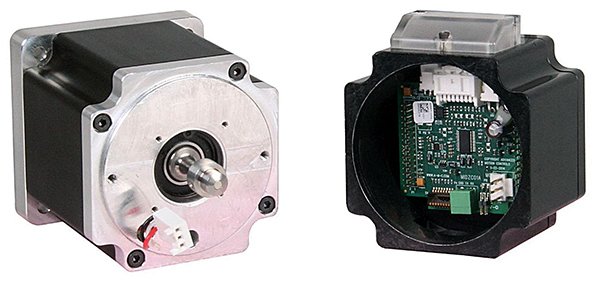
Complete servo motor assemblies can include the entire motion control system. The separated housing details both the motor, with end shaft magnet, and complete electronics sections. The compact end assembly houses the encoder, servo drive with internal motion control, external I/O and digital network communications for standalone capability and operation (courtesy of ADVANCED Motion Controls).
Speed
The applied voltage to a motor is directly proportional to motor speed. Where higher or lower speeds are required, applied motor voltage may limit desired outcome. However, stator windings can easily be made to specifications that allow for increased or decreased speeds given the voltage requirement, with consideration for torque. This factor is called Ke and given in Volts/krpm and can have a wide range of possibilities.
Torque
Available current to a motor is directly proportional to motor torque. Where increased or decreased torque is needed, available current may not always be in line. As well with speed, the stator winding specification can easily be made to increase the torque for lowered available current, with consideration for speed. This factor is called Kt and given in Nm/Amp. Another option to increase torque, where plenty of current is available and overall length is not an issue, is to add to the stator length and/or number of stacks while retaining the frame size.
Voltage
The nominal or expected voltage sourced to the motor will determine the speed (see above). The windings in the motor are produced knowing that applied voltage. Since power electronics are in the system, i.e. servo drives, the resulting voltage the motor observes is considered DC, whether the power to the electronics is connected to a DC source or rectified DC from an AC line. Motor windings can therefore explicitly be specified for any voltage, including 10-80+ VDC for low voltage needs, typical: 90, 120, 240, 480, 525 VACs line sources or higher. Knowing supply voltage is critical to any application success.
Inertia
The overall design of the rotor results in the angular mass and determines needed torque while accommodating targeted acceleration/deceleration aspects. Considering in advance all aspects of design and materials, load inertia matching can be key specifications to a given application. Mismatches in inertia can be of large concern given overall momentum of the load.
Frame size
Sizing is typically predicated by the torque requirements. As standards are always available, so too come with them the general constraints of housing sizes. When defining specifications to any given application, these can readily be opened for ‘best fit’ considerations while not having to follow any ‘standard’ as desired for operation. As well, frame-less motors allow for stators to become a part of the machine frame itself and are increasingly popular while driving down overall costs/size.
IP rating
Ingress Protection ratings afford the application proper sealed motor enclosures as required. Increased protection comes with vastly improved sealing, and with multiple methods, for both the housing portions and bearings where required.
Mounting
Again, standards are readily available but can also be expanded where additional requirements may be desired. Not having to follow a pre-determined mechanical interface allows for increased options.
Shaft
Typically, these are stainless steel with available standards defining potential interface to the motor. However, multiple alterations of material and configuration can be specified as deemed necessary by the developer/application. This ranges widely and includes specifics for diameter differences, shape variations, keying, etc.
Housing Material
With housings typically made from aluminum, or powder coated external laminations, and the fact that they can see differing environmental conditions, dictates reviewing all types of variations to match application needs. Metals and coatings can be specified as required to match expected use.
Wiring/Connection
Multiple variations for termination of wiring to the motor can be made. Available components can readily be applied or, specifying both wire and connector types, can easily be adapted.
Gearbox/Actuator
As the motor itself becomes part of a larger assembly, incorporating other mechanical aspects such as gearing or actuation, the new ‘system’ can be made to stand alone. This further reduces size and unit costs to be inclusive as an ‘all-in-one’ component.
Brake
As another optional component to ensure proper application solution, adding brakes to a motor can easily be achieved where necessary and included as part of the motor system.
Feedback
Many market encoding devices are available and can be specified as required for the application. Usually rear mounted, this portion of the rotor’s shaft can be altered as needed and the end cap of the motor modified to fit overall motor design.
Electronics: Drives/Networks
Incorporating the drives power electronics and digital network is another trend in servo motor technology. This further reduces not only the number of machine components overall but also the complexity of the wiring. In the age of Industry 4.0, the ability to incorporate intelligent electronics in the motor is here to stay.
